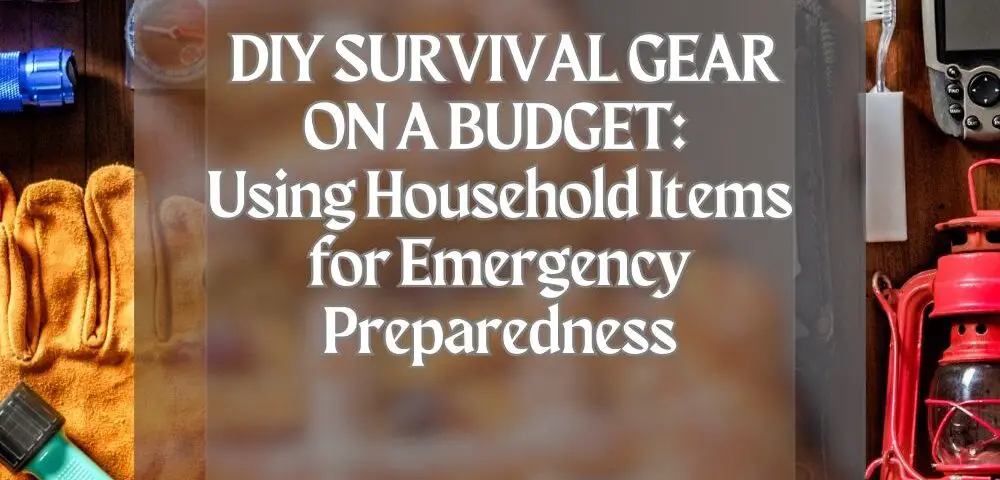Written by Bernie Carr
Prepping can get expensive, especially if you focus on acquiring gear. But before spending money, why not try some DIY hacks, using items already lying right in your own home. Let’s look at how common household items can be repurposed into effective survival gear.
Emergency Water Filtration: Turning Everyday Items into Lifesaving Tools
Water is essential for survival, and in an emergency, access to clean water may be compromised. Transform a plastic bottle into a makeshift water filter by cutting off the bottom and placing a layer of charcoal, sand, and gravel inside. This DIY filter can significantly improve water quality, making it safe for consumption. You can also use bleach to purify water, but it has to be plain, unscented bleach, using these instructions.
Or, try the SODIS method of water purification: Just purify water using the sun’s rays. If the water you will be purifying is too murky, you’ll need to filter it first. Use a bandanna, coffee filter, paper towel or even a clean t-shirt to filter out any soil and other solids from the water.
Fill the bottle with clear water.
Shake the bottle well.
Set the filled bottle out in the sun for six hours on a sunny day. If it cloudy, then you need to leave it out for two days. UV rays destroy bacteria, and the heat generated speeds up the process.
Firestarter Hacks: Igniting Flames with Household Items
Fire is a fundamental survival tool, providing warmth, cooking capabilities, and a means of signaling for help. Instead of relying on traditional fire starters, consider using household items like cotton balls soaked in petroleum jelly, or dryer lint encased in cardboard egg cartons. These simple solutions can ignite a fire even in adverse conditions.
Improvised Shelter Construction: Utilizing Household Materials for Protection
In emergency situations, having shelter is crucial for staying safe and maintaining body temperature. Turn everyday items like trash bags, ponchos, or mylar blankets into makeshift shelters. These materials are lightweight and compact, making them ideal for inclusion in your DIY survival kit.
Everyday Tools as Multipurpose Survival Instruments
Your everyday toolbox can be a goldmine for survival gear. Duct tape, for example, is a versatile solution for makeshift repairs, bandages, and even constructing shelters. Multi-tools, common in many households, can serve a variety of functions, including cutting, opening cans, and even acting as a makeshift screwdriver. Here are four emergency hacks you can use to open a can if you don’t have a can opener.
DIY First Aid: Turning Household Items into Medical Supplies
In emergencies, access to medical supplies may be limited. Your household can provide valuable resources for creating a makeshift first aid kit. Use clean cloth or clothing for bandages, plastic bags as improvised gloves, and even sanitary napkins for wound dressing (this is even mentioned in the National Library of Medicine). Remember to include any over-the-counter medications you may have on hand. Petroleum jelly and Vicks Vapor Rub both have multiple uses.
Food Preservation and Preparation: Making the Most of Your Pantry
In a survival situation, proper nutrition is essential. Extend the shelf life of perishable items by dehydrating fruits and vegetables or canning them. My in-laws used to dehydrate meat by hanging the pieces on a clothesline exposed to air and the heat of the sun.
Create an improvised camp stove using a tin can and rubbing alcohol for cooking meals. Your pantry holds a wealth of resources that can sustain you in challenging times.
Use Common Sense
Of course, common sense is key when making survival gear from household items. Some hacks, though popular, don’t work. As an example, I tried that crayon candle hack that’s been going around the internet for years. The crayon doesn’t light, and even if it did, it’s just too unstable and could just fall over and start a fire. But other light hacks do work, such as making a vegetable oil lamp.
The Final Word
Being prepared doesn’t always require expensive, specialized gear. By tapping into the potential of common household items, you can create DIY survival gear that is both effective and budget-friendly. Whether you’re facing a natural disaster, power outage, or unexpected outdoor adventure, the versatility of everyday items can make all the difference. Equip yourself with the knowledge and skills to transform the mundane into the extraordinary, ensuring you’re ready for whatever challenges may come your way.
*We are an affiliate of Amazon.com, which means we received a small commission if you click through one of our Amazon links when you shop, at totally no cost to you. This helps keep the lights on at the blog. Thanks!
About the author
Bernie Carr is the founder of Apartment Prepper. She has written several books including the best-selling Prepper’s Pocket Guide, Jake and Miller’s Big Adventure, The Penny-Pinching Prepper and How to Prepare for Most Emergencies on a $50 a Month Budget. Bernie’s latest e-book, FRUGAL DIY has just been released on Amazon. Her work appears in sites such as the Allstate Blog and Clark.com, as well as print magazines such as Backwoods Survival Guide and Prepper Survival Guide. She has been featured in national publications such as Fox Business and Popular Mechanics. Learn more about Bernie here.
FB: https://www.facebook.com/apartmentprepper
Instagram: https://www.instagram.com/apartmentpreppers/
Twitter: https://twitter.com/AptPrepper
YouTube: https://www.youtube.com/channel/UC7vOtdbo-wiBeBxD6puCr1Q
Patreon: https://patreon.com/apartmentprepper
Pinterest: https://www.pinterest.com/aptprepper/
Today’s societal climate not supportive of prepping. With your help, we can keep bringing you content that is often suppressed. Help keep Apartment Prepper alive.
Join me on Patreon for ad-free content.

Or Help out via Paypal




Hi Bernie. Great article. Great because, if a crises does occur, the odds are that you won’t be home with your stockpile of food, blankets, and flashlights. You’ll be on the road in your car or at work or on vacation. One thing that always concerns me when thinking about that kind of situation is LIGHTING. And one way to improvise lighting is the use of olive oil lamps (though it needn’t be “olive” oil; cooking oil of all kinds can be used). The info in my book, “Olive Oil Lamps,” can help provide usable LIGHT when not even one candle can be found. Google for “non-electric lighting by ron brown.” Personally, I think the time for “prepping” is becoming more and more important. And KNOWLEDGE is likely the most important prepping item of all.